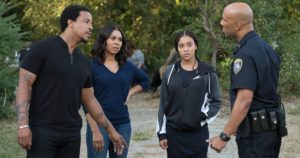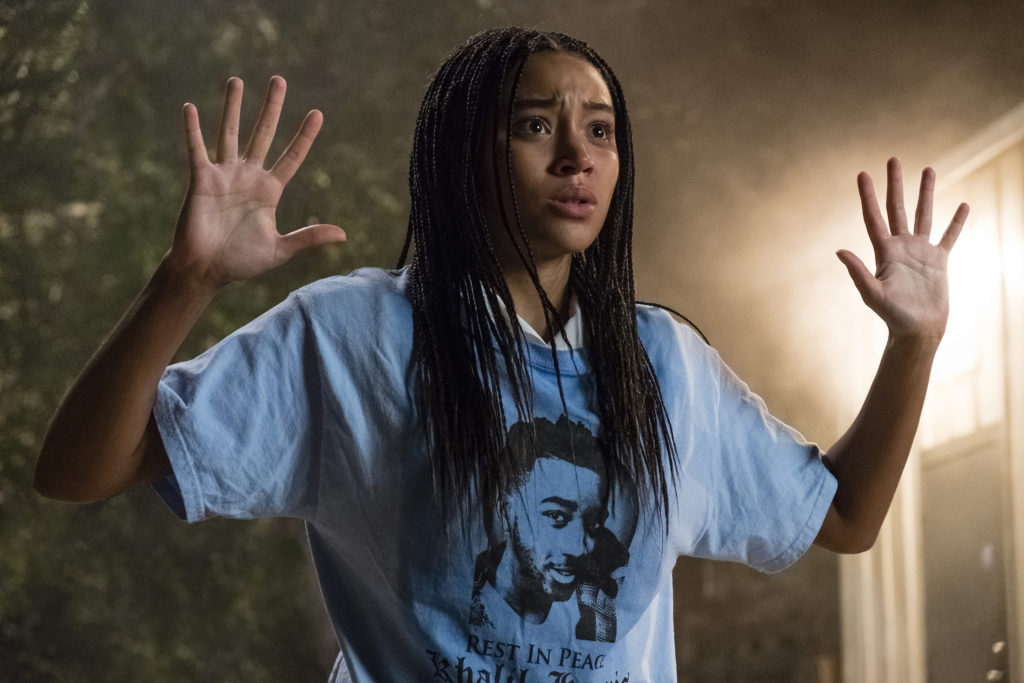
From the outset, The Hate U Give shows a commonplace but not ‘normal’ environment. It shows Garden Heights, a fictional neighborhood with mostly African American residents. It then pans and zooms within the Carter household. There, Starr is getting a talk that most non-black people don’t get. Her father Maverick (Russell Hornsby) teachers her and her brothers two complimentary lessons. The first is how to behave when a police officer stops their car without justification. The second is the Black Panther bill of rights. Starr and her family shouldn’t have to fear members representing the government but that’s a sad reality.
Starr eventually grows up to be a teenager (Amandla Stenberg) whose parents eventually get her to live a normal life. She, like her half brother Seven (Lamar Johnson), don’t go to the dangerous neighborhood high school. Instead they go to a private one where most of the student body has post secondary school possibilities. Despite that, their neighborhood is still a part of them, the place where they made friends they knew since childhood. She gets into a car with a friend, Khalil (Algee Smith). Then she watches him die under the gunfire of a trigger happy white police officer. There goes her normalcy.
The Hate U Give gets its story from Angie Thomas’ tome of a young adult bestselling. This is in Amandla Stenberg’s wheelhouse. This is her fourth appearance in such a movie adaptation and the best in that genre. We’ll talk about the other elements that comprise such an effective work. But for now we’ll start with the first one. As trite as this sounds, those other adaptations show a dystopic future while this one shows dystopia as the present. People today suffer under both police brutality and gang violence. And the film gives equal weight to those factors in Starr’s life.
Starr is a survivor and her best friend Kenya (Dominique Fishback) tells her to do something about it. Another one of The Hate U Give‘s assets is that conversation, which is short and nebulous. It’s part of Audrey Wells’ script with such craftsmanship, smoothly and naturally portraying a community with contradictory motivations. People pushing her to reveal or not the worst kept secret about her being the witness to Khalil’s death. Kenya’s on the yes camp while Starr’s mother (Regina Hall) is on the no camp. She wants to protect Starr from the public, dangerous nature of speaking the truth.
The other person on the no camp is King (Anthony Mackie). He’s Maverick’s ex best friend and Kenya’s father who malevolently ‘runs’ Garden Heights. There’s one consequence to Starr talking to a grand jury about Khalil. That jury will be more interested in him than they are about the white police officer who shot him. Which means they’ll find out that he was a drug dealer working for King. And King wouldn’t want a jury to know that he ropes unemployed young men into selling narcotics. Starr has motivations for incorporating King into Khalil’s story that may or not involve Maverick.
The Hate U Give also gives enough focus on Starr’s complex family structure. She and Seven are siblings through Maverick, his biological mother being Iesha (Karan Kendrick). She’s a less than classy woman who is now shacking up with King. Sekani (TJ Wright) is her full brother who has the antics of a regular kid. But he also bears the emotional brunt of treading the same path she did as a kid. Stenberg’s chemistry with all of these equally great actors are astounding. And her primal rage when she breathes life into Starr’s trauma is a revelation.
The film, nonetheless, doesn’t make that intrigue pulpy. Instead, it balances subtlety and drama in approaching its tangled webs. One thing to remember is that it gets its title from a Tupac song that’s open to interpretation. And interpretation that helps guide Starr’s life. That’s because of or despite of her carrying the histories of her family and her country within her mind. It even guides her as she navigates Garden Heights and her high school, which has a predominantly white student body. Starr is not a blank sheet, yet her high school friends are oblivious to her burdens.
And the film visually establishes the differences between the two worlds where Starr doesn’t believe she belongs. Garden Heights is vibrant and warm, if not arid while her school has cold, rigid lines. Tillman Jr. uses distinct color palettes for both worlds. Eventually, there’d be flashes of red during the city hall scenes or sleek black streaks in Garden Heights. This symbolizes, obviously, not just Starr being true to herself despite living in both worlds as well. It also represents a compromise between those racial divisions. This would be obvious under the hands of a weaker director. But that, as with its many elements, are effective here.
- Release Date: 10/11/2018


